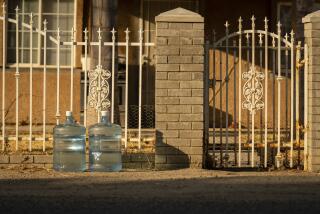Thirst for Answers Now to Prevent Water Shortages
- Share via
Most people think about water only in that brief instant before they turn on a faucet. When the water flows, as it almost always does, they simply go on with life.
But what if it doesn’t? In the coming year, both weather and politics could affect California’s water supply. We need to take decisive action now to avoid a water crisis like the energy crisis.
In urban Southern California, the average family of four living in a single-family home pays about $30 per month for all the water they need. The same family pays $60 to $90 per month for electricity and nearly $800 for groceries.
It takes a drought, earthquake or terrorist attack to make us think about the value of our water supplies. While this winter’s rain and snowfall levels seem to be healthy, all we need is a dry year or two and we’ll have severe water shortages in many parts of the state. So what do we do to avoid a water crisis?
First, we must start taking responsibility for our water use. Californians are capable of conservation; we used 8.8% less electricity during peak hours in October 2001 than the year before. There is no reason we cannot expect the same kind of widespread support for water conservation.
Second, elected officials, water district managers and business, agricultural and environmental leaders must implement final agreements on the CalFed program. CalFed is a collaborative state and federal effort to save the Sacramento-San Joaquin Delta, a system of waterways that provides drinking water to two-thirds of the state and irrigation water to more than 7 million acres of farmland. Advancing the CalFed program is critical to replacing water that will be lost when California is required by the federal government to live within its allocation of Colorado River water. By following through with the agreement, we can ensure there is enough good water for the environment, people and economy of California for 30 years or more.
Third, we must recognize that many of the solutions to our water problems can be found at the local and regional levels. There are ample opportunities to make our existing water system in Southern California more efficient and less dependent on imported water, such as conservation, recycling, ground water storage, desalination and cleanup of contaminated ground water basins.
Two laws that just took effect this month will strengthen state laws that require a demonstration of sufficient water supplies to meet water demand before approving large new residential or commercial developments.
This will test our resolve to adequately plan and provide for our future.
If we have learned anything from last year’s energy crisis, it is that some disasters can be avoided by getting the word out early. We should not wait for our state’s water shortage to become a segment on the evening news before we do something.
More to Read
Sign up for Essential California
The most important California stories and recommendations in your inbox every morning.
You may occasionally receive promotional content from the Los Angeles Times.













